|
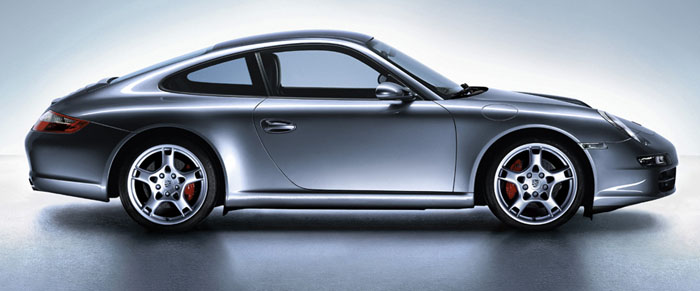
2005 Porsche 911 Carrera S
The world's next dream car gets even better with the 2005 Porsche 911 Carrera S - Porsche has increased the engine power yet again in comparison to the 911 Carrera. "S"
- a Porsche symbol denoting increased power - has long achieved legendary status . The legend now continues with this precision driving machine.
The 911 Carrera S model is armed with a 3.8-liter displacement engine offering 355 horsepower at 6,600 rpm. Maximum torque is 295 pound-feet at 4,600 rpm. The
impressive output is capable of propelling the Carrera S from 0-to-60 mph in 4.6 seconds and to a top track speed of 182 mph (manual transmission model).
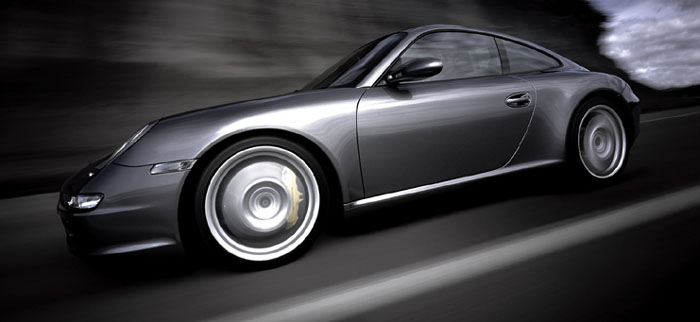
Manual Gearbox
The new six-speed manual gearbox is designed for optimum performance. Each of the six ratios has been carefully selected to take maximum advantage of the engine's
extraordinary power and torque. The gearbox is driven through a dual-mass flywheel, which helps minimize noise in the drivetrain. Noise is further reduced by the
cable-operated gear linkage, which insulates the lever from the engine and gearbox. The gear lever throw has been shortened by 15% without sacrificing smoothness or
precision. This translates into faster, more positive gearshifts requiring minimal effort from the driver. Gear selection is further enhanced by the race-inspired pedal design
and placement. The gearbox is mated to a high-performance self-adjusting clutch. The result is a substantial reduction in the added release loads, which are normally encountered as the clutch begins to wear.
Tiptronic S
The highly advanced Tiptronic S transmission is available as an option. This versatile gearbox combines fully automatic five-speed operation with the capability of manual
control. In automatic mode, Tiptronic S has different gearshift patterns ranging from "Economy" to "Sport." Depending on driving style and the topography of the road,
Tiptronic S selects one of these five patterns and applies the optimum sequence of gearshift points. Even in automatic mode, the rapid gearshift action ensures a fast and
agile response. Within a short space of time, the driver will develop a feel for the system and learn to influence the gearshifts using the throttle alone. In manual mode,
the driver can change gear by hand using rocker controls located on the steering wheel. Simply press up to change up and down to change down. The system responds
smoothly and immediately to every driver input with virtually no interruption in drive. This race-derived function is particularly useful when performing an overtaking
maneuver. If there is no manual input for a period of eight seconds, the system reverts to automatic mode. The overall performance of the Tiptronic S compares favorably with that of a standard Porsche manual gearbox.
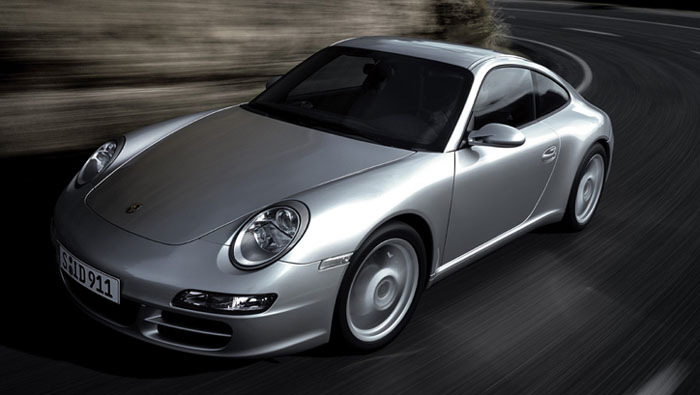
Chassis
Not surprisingly, the new 911 complements its powerful engine with an equally advanced and performance-oriented chassis. The car responds immediately to the
driver's input with an exhilarating degree of precision and confidence-inspiring control. For optimum balance and stability, the wheel track has been increased by 0.82 inches
at the front and 1.33 inches at the rear. In addition, a special emphasis was placed on weight reduction. For example, a new lightweight rear suspension strut with aluminum
damper replaces the previous steel design. The resulting weight saving is approximately 70%. Less weight equals quicker acceleration, better braking and
smoother handling transitions. The standard chassis on the new 911 Carrera S rides 0.39 inches lower than on the 911 Carrera. Other unique features include continuous
damping control in the form of Porsche Active Suspension Management (PASM).
Pitch and roll have been significantly reduced, as have road noise and vibration. Overall
agility is remarkable with excellent suspension response on most driving surfaces and in most conditions. The front axle design is based around a new evolution of our proven
McPherson Strut layout. The wheels are located with absolute precision by means of longitudinal and transverse links connecting to specially reinforced hub carriers. This
design approach delivers excellent straight-line stability and superlative turn-in during cornering. The rear axle structure is a new and lighter development of Porsche's
subframe-based multi-link LSA suspension (Lightweight, Stable, Agile). Plus, the revised kinematics at the rear of the car also provide added stability under acceleration.
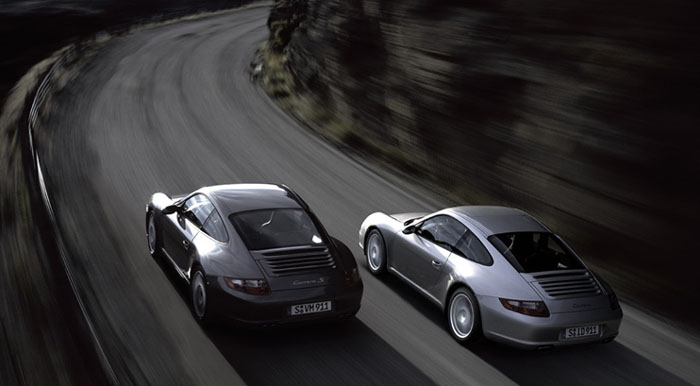
PSM
PSM is an automatic control system offering valuable assistance in specific, critical driving scenarios and to accomplish this, PSM uses a range of sensors to monitor the
direction, speed, yaw velocity (speed of rotation around the vertical axis) and lateral acceleration of the car. Based on this information, it can then calculate the actual
direction of travel. If the car begins to oversteer or understeer, PSM applies selective braking on individual wheels to bring the car back into line. Whenever PSM is forced to
intervene, an indicator light in the cockpit is illuminated. Another scenario where PSM can assist the driver is when applying the throttle on wet or other low-grip surfaces.
Here, PSM uses the ABD (automatic brake differential) and ASR (anti-slip regulation) functions to maintain traction and stability.
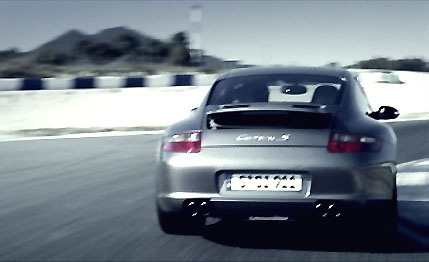 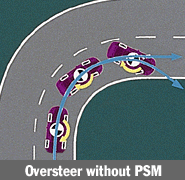
Included as standard equipment on both new 911 models, the latest generation of PSM allows considerably more freedom to explore the car's performance. All PSM inputs are
much more precise, thereby enhancing the agility of the car. When "Sport" mode is selected on the optional Sport Chrono Package Plus, the PSM threshold is further
extended to enable greater driver involvement -- particularly at speeds up to 44 mph. Also included in the Chrono package is a modified ABS offering shorter braking
distances. Occupant comfort has also been improved by refining all potential PSM inputs. If you'd rather enjoy the 911 unassisted, the PSM system can be disabled
leaving only the automatic brake differential in place. To ensure your safety, PSM remains present in the background and will only intervene under heavy braking where at
least one front wheel requires ABS assistance. With its unique combination of precision, stability, safety and performance, Porsche Stability Management is a natural application of the Porsche engineering philosophy.
Sport Chrono Package Plus
The new Sport Chrono Package Plus option is an all-new integrated system providing simultaneous enhancement for engine, chassis and the optional Tiptronic S
transmission. The results are even greater performance and pleasure from your Porsche. Pressing the "Sport" button on the center console is all that's required to begin
exploiting the new 911's generous reserves of power and agility in a more immediate manner. In Sport mode, the engine management system's variable parameters are
recalibrated to enhance engine response. A modified throttle map empowers your right foot with more progressive reaction to each tap of the accelerator. In higher gears, a
rev-limiter works in tandem to offer additional protection for the engine under acceleration.
On vehicles with Tiptronic S transmission, automatic gearshifts also become faster and
more dynamic. Lift off the throttle – even at high revs – and the system immediately shifts down to apply engine braking. Unwanted upshifts in manual mode are also
prevented, even as you approach the engine's rev limit. The payoff? More secure and predictable handling, particularly in the corners. While all of this is happening, PASM
switches to a more rigid setup with firmer electronic damper settings for precise cornering, improved high-speed stability and tenacious road-holding traction. (PASM, or
Porsche Active Suspension Management, standard on the 911 Carrera S). Porsche Stability Management is also performance-optimized by raising the thresholds for
triggering automatic intervention by the ABS and engine management systems, resulting in a more natural response, but less forgiving to lateral and longitudinal g-forces.
A digital/analog timer mounted on the center dashboard keeps score, measuring time as deftly as the 911 concept transcends it. To help you gauge your 911's performance in
a more exacting manner, a digital/analog stopwatch tracks time from hours down to hundredths of a second. Driving times can be recorded for any stretch of road, and
benchmark times can be defined. Stopwatch functions are operated using a control stalk mounted to the side of the steering wheel, and data is continuously fed to an on-board
computer integrated into the Porsche Communication Management (PCM) system. A second digital display located on the instrument cluster gives your eyes another option
for viewing time information, while the PCM display lets you analyze detailed performance data at your leisure. The system records and displays the time and
distance traveled on the current segment, number of segments completed with respective times and the fastest segment. Other useful features include a memory
function controlled via the PCM system which can store a range of personal preferences.
Wheels
The 911 Carrera S are equipped with new and larger alloy wheels that improve overall handling and traction. with 19-inch wheels have a wider diameter and run flush with the
body of the car. As well as providing a larger footprint and increased grip, the wheels are a major feature of the sleek and athletic exterior design
Brakes
Improvements have been made that elevate braking power and performance while adding a decisive margin of safety and control. Race-bred four-piston fixed monobloc
calipers, each cast as a single unit of aluminum, generate a stopping force significantly more powerful than the 911's upgraded engine. A fixture on modern-day Formula One
race cars, monobloc brake designs are extremely rigid and lightweight with more precise pedal response. The calipers are quick to grip and release. Pedal travel is short and
easy to modulate. Together with the latest four-channel ABS and an increase in the tandem brake booster, the result is greater ride comfort with extra control under hard braking or on uneven surfaces.
Superior braking in wet weather is facilitated by cross drilling the 911 Carrera's massive brake discs to dissipate water vapor pressure. Each disc is also internally vented for
improved heat dispersal and reduced fade. Brake cooling is enhanced even further by an aero-dynamically optimized underbody lining and larger air ducts at the front of the car
that redirect the jet stream directly onto the brakes.
The added horsepower of the 911 Carrera S is matched with bigger, more robust four-piston calipers at all four corners. The brakes are derived from the 911 Turbo and
feature the same distinctive red paint finish.
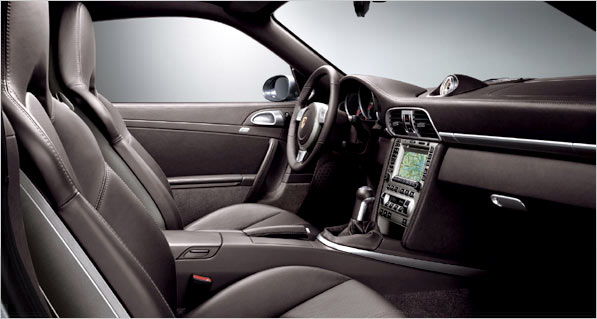
Cockpit
The performance of the new 911 is not limited to what's in the engine compartment. Inside the cockpit, you'll find yourself surrounded by features that respond instinctively
to your demands. Previous 911 owners will notice an ergonomically optimized interior whose restyled controls and tactile qualities still retain their familiar, driver-oriented
design philosophy. Components are positioned with unobstructed views. Controls are intuitive in operation and always close at hand, particularly when coupled with a new
multi-function steering wheel offered for the first time as an option on the 911. The fully automatic climate control system and active carbon filter goes even further, requiring no driver interaction at all.
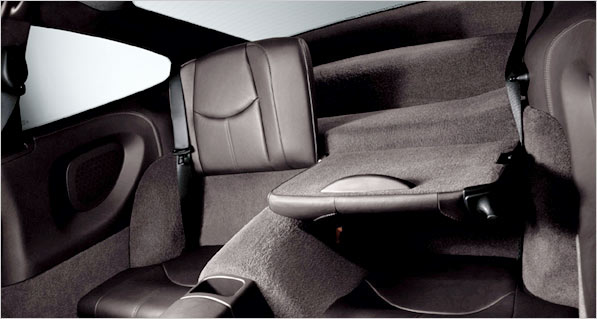
Perhaps nowhere is the new 911's pure Porsche lineage more evident than the left-hand placement of the ignition key – a quiet tribute to the days of the "Le Mans start", when
drivers would sprint to their cars and start the engine with one hand while shifting into gear with the other. Weekend exploration along winding country roads reveals another
nuance of the new 911: reengineered front seats with improved lateral support to clarify the connection between car and driver.
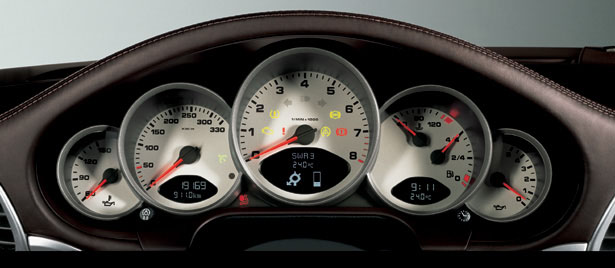
The five round dials punctuating the middle of the instrument panel are as much a hallmark of a Porsche's interior as the crest on its steering wheel – unmistakable
testaments to the 911's racing heritage. To aid drivers looking for vital engine speed information while racing down the Mulsanne Straight at upwards of 200 mph in the dark
at Le Mans, Porsche fitted an extra-large tachometer front and center. Then enhanced it with clear, easy-to-read analog markings. Today, the gauge cluster is still highlighted
by the traditional center-mounted tach. Of course, every feature on our new 911 models has been honed with a decidedly modern interpretation of classic Porsche design. A
cascading layout with wider spacing and brilliant backlit illumination at night combine to improve legibility across the board. Large analog gauges, ideal for conveying
information at-a-glance, are embellished by digital displays that feature a new dot-matrix technology for higher resolution icons and text. Within the most prominent
display, a digital speedometer is augmented by a variety of information that can be summoned on cue – from CD song titles to trip computer calculations and more.
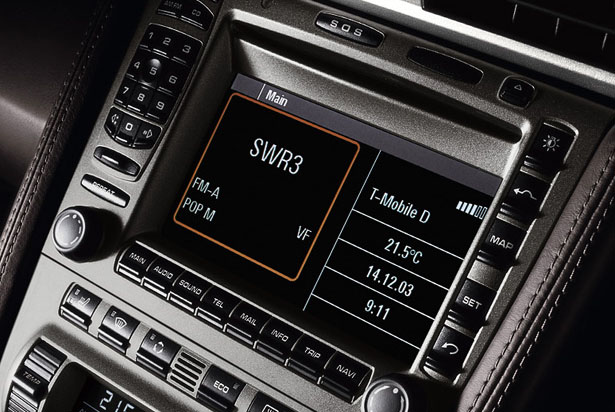
The Porsche Communication Management (PCM) system transforms the 911's center console into an autobahn of information and entertainment. An upgraded
high-resolution display with simplified menus offers instant access to a high-end tuner with CD player, a trip computer, and options ranging from GPS navigation to memory
functions for the Sport Chrono Package Plus. The dual-channel RDS tuner allows you to store up to 40 presets and search for stations by format. PCM also displays the names
of stations and CD tracks inside the instrument panel's center dial, allowing you to keep your eyes front and center while driving. A control stalk on the side of the steering
column lets you tap into PCM's trip computer and display real-time data ranging from average speed and fuel consumption to the elapsed time, outside temperature and
more. The trip computer also interacts with the GPS navigation system to reveal driving range, distance to your destination and estimated time of arrival.
- Rear-mounted, 3.8 liters, 6 cylinder
- 355 hp (SAE) @ 6,600 rpm
- Torque 296 lb-ft @ 4,600 rpm
- 0-62 mph: 4.8 sec.
- Top Track Speed: 182 mph
- USD 79,100.00 MSRP
|









